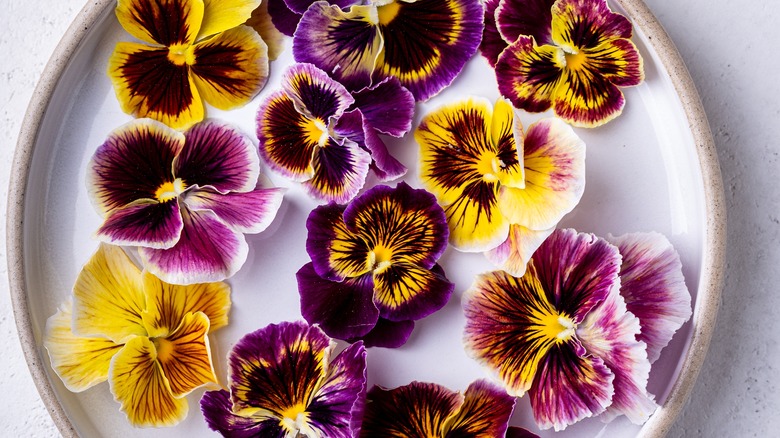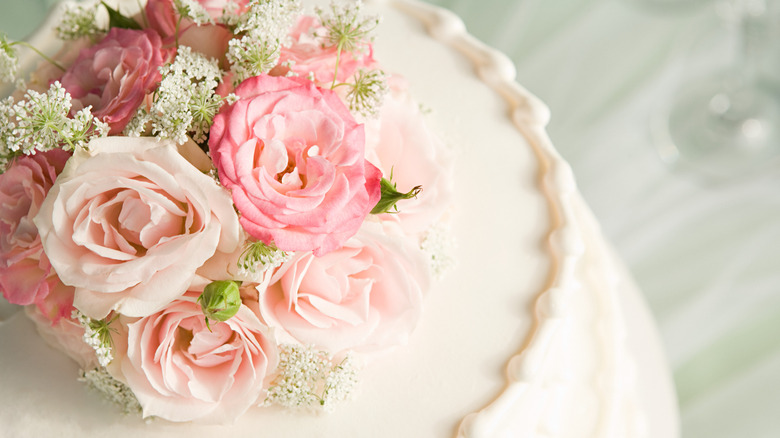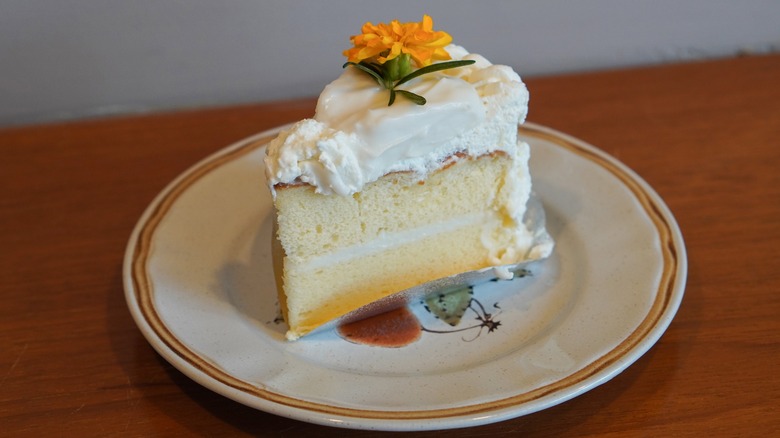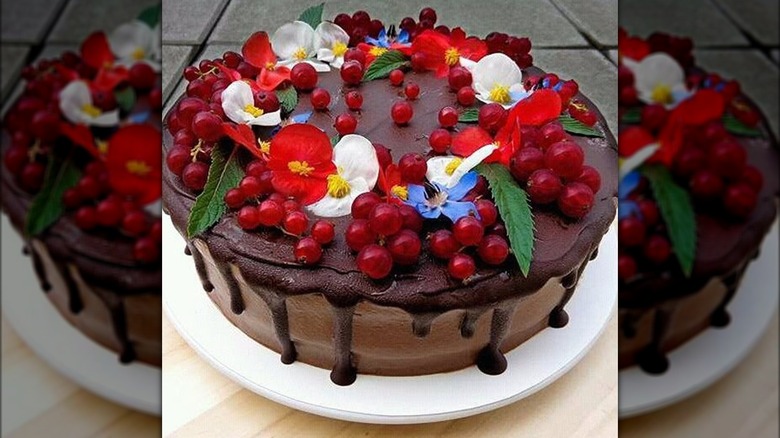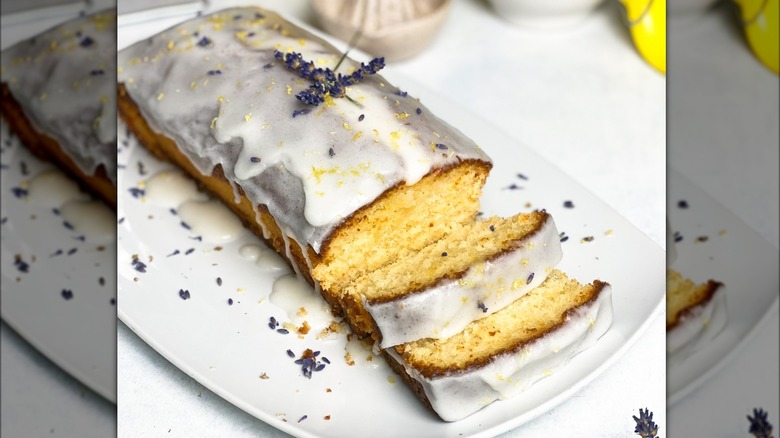13 Best Edible Flowers To Top Off Your Cake
If you're artistic-minded, you know that the decorating stage is the most fun part of baking a cake. While the ingredients that make up the batter are important to the final product, the cake's appearance is the first element that draws eaters in. You could work on your piping skills to decorate the cake with elaborate patterns or resort to shiny dragées or marzipan creations, but there's a simpler option that's far more striking: flowers. To be clear, there's nothing new about consuming flowers, as various cultures have included them in their diets for millennia. Of course, you can't just pick any wildflower and expect good results, since many varieties are poisonous. Additionally, you'll want to be sure the flowers don't come from a garden that has been sprayed with pesticides.
We spoke to some edible flower pros to help guide you in your cake-decorating journey. Loria Stern is a baker, botanist, gardener, artist, and entrepreneur behind Eat Your Flowers in Los Angeles, the original edible flower bakery. Vitaliy Klimov also shared plenty of advice about using edible flowers in baked goods, thanks to his experience as the product manager at Greeneration, a high-end vertical farm based in Dubai that specializes in premium edible flowers, specialty leaves, and microgreens specifically tailored for the fine dining sector.
Read on for their recommendations for the best flowers to use for topping your cakes. Whether you're going for classic vanilla, decadent chocolate, or a fruity combo, this selection will provide you with a starting point for all your floral needs.
1. Viola
Baker Loria Stern is fond of using violas to decorate her cake creations and notes that they are "delicate, colorful, and easy to use." For first-time flower eaters, this bloom is a good starting point for experimentation and consequently, it's quite common. Greeneration's product manager Vitaliy Klimov says, "Viola is the most versatile edible flower — 90% of people who say 'edible flowers' mean it." The flat petals are part of their appeal, as they can easily be placed on the tops or sides of cakes. Additionally, Klimov says they are easy to dry, which is a good way to preserve them for future use.
There are also several types of violas, including pansies, which display vibrantly-colored edible petals that work well as decorations. Purple, blue, yellow, and white petals are some of the options, though not all colors are an optimal choice for aesthetic purposes. For example, Klimov warns, "white violas will not be noticeable on light cream." When choosing which variety to use, double-check that it is indeed edible, as not all violas are safe to consume. Expect a subtly sweet and perfumed flavor, with a fresh taste similar to lettuce. Meanwhile, you can also choose to crystallize the petals by brushing them with egg whites and sugar (or aquafaba and sugar for vegan baking) and letting them air dry.
2. Nasturtium
Nasturtium flowers have vibrant orange petals and green leaves. While the leaves are nice for savory dishes, the petals work well for desserts, namely cakes. Loria Stern describes them as having a "bright, delicate, and peppery flavor," with a pleasant aromatic touch. The flower is on the bolder end of the flavor spectrum, so if you don't want to overwhelm subtler ingredients, it may be best to skip nasturtium or use the petals sparingly.
Vitaliy Klimov says that "nasturtium will go perfectly for bitter chocolate," and Stern agrees, also pointing to the bold orange color as a dazzling contrast for dark chocolate. A large part of the appeal of using edible flowers is aesthetics, and the bright hue stands out against a chocolate or vanilla frosted cake. Additionally, Stern enjoys using the orange petals for fruit-based cakes to add a burst of color and a kick of flavor. Match it with orange-colored fruits like apricots for a double dose of color, or use it to contrast berries.
3. Sunflower
Sunflowers are dazzling blooms that stand tall among the rest, with plenty of edible uses from the seeds to the petals. The flavor of the latter is slightly bittersweet with a hint of nuttiness, making them a pleasant pairing for a variety of cakes. Loria Stern likes sunflowers for their versatility and suggests using the petals as a contrast for dark chocolate, whether to decorate a chocolate cake, glaze, ganache, or frosting.
The edges of the petals can be bitter, so you might want to taste them first to decide which parts to discard and which to keep. Counter some of those notes with a sweet frosting, or crystallize the petals before delicately placing them on your creation as an artistic garnish. You can prevent the bitterness from dominating by cutting the petals into thin strips to sprinkle over the surface of the cake.
4. Rose
Roses with chocolate are a popular gift, but people usually only consume the latter. There's no reason why you shouldn't be consuming the flowers though (as long as you know they have not been sprayed with chemicals). Instead of chomping down on the petals, use them to garnish a cake — chocolate or otherwise. Loria Stern comments that roses are "classic, romantic, and easy to find," making them a good choice for decorating a sweet treat without too much fuss.
Most people have smelled roses, and the taste of the petals can vary just as widely. Though, darker-hued flowers are typically more intense. Some taste like strawberries or green apples, with a sweet floral aroma similar to the taste. The petals also have a silky smooth texture with a slight bite, which can be further enhanced by crystallizing them prior to use.
Stern suggests pairing chocolate cake with darkly-hued roses for a dramatic flair. Meanwhile, she says that a cake with a rich buttercream frosting pairs well with "bold, statement flowers like garden roses." Similarly, vanilla or classic pound cakes benefit from the delicate flavor and would be well-suited for pale rose petals.
5. Dahlia
Dahlia lovers have an extensive selection of blooms to choose from, though not all are that interesting to eat. Consider whether you're going for more of an aesthetic quality or if you prefer to use the flowers for their flavor. From there you can choose the specific type of dahlia for topping your cake. Loria Stern recommends them for beginners, as the taste is generally "fresh, crisp, and subtle," which is easier for pairing purposes. Some people compare the flower to lettuce, celery, or water chestnut and emphasize its juicy nature.
On the decorative front, Stern suggests using dahlias to garnish buttercream cakes, as the dazzling flowers can properly stand out against a blank canvas. On the other hand, she also likes pairing burgundy-colored dahlias with chocolate cake or frosting to create a bold, dark effect. With hues encompassing pinks, reds, oranges, purples, and yellows, there are countless ways to complement the rest of the cake toppings.
6. Peony
Loria Stern likes peonies for their bold shape — which makes them truly stand out. To amplify the effect, she recommends using the luscious petals to top buttercream cakes. The delicate petals are light and airy like lace and have a soft and buttery texture. In some cases, their scent can be similar to roses, yet with a subtler note. As such, people who find roses a little too perfumed might enjoy the taste of peonies as a starting point for decorating cakes.
The flower tastes a bit like peach or strawberry, which makes it an excellent pairing for baked goods. Follow in that vein by layering petals over the cake's surface along with thinly sliced peaches or halved strawberries. Additionally, peonies complement most fruits and berries and add a floral element to their taste. For a sweeter twist, sprinkle the petals with granulated or confectioner's sugar. With pink hues ranging from pastel to a deep blush, this flower makes a charming garnish for vanilla buttercream and fruit cakes.
7. Marigold
Marigolds are fairly versatile in the edible flower world, and Loria Stern describes them as being "fragrant, bright, fun evoking." Those qualities make them a good match for cakes that don't have a ton going on already. The flower's taste is reminiscent of saffron and citrus, which opens up a range of pairing ideas for the petals.
For example, Vitaliy Klimov suggests, "To my taste, marigolds are well suited for fatty creams; their citrus aroma goes well with the creamy flavor, and the firm texture contrasts pleasantly with the softness of the cream." One-note cakes get old fast, and Klimov's advice helps introduce novel flavor and textural components to ensure every bite is an exciting treat.
On the other hand, he warns against pairing them with yellow and orange fruits as the taste and flower petals won't stand out against the other ingredients. Avoid overdoing it with marigolds; instead, sprinkle thinly shredded petals over the cake's surface to infuse it with flavor.
8. Cornflower
Cornflowers have a star-like daisy shape and come in white, pink, blue, and purple hues, though blue varieties are the most common. They can be used as food dye, tingeing a rich white buttercream frosting with their vibrant colors as a contrasting touch. The taste is far subtler than the visual appearance of the bright blooms. Expect sweet floral notes with a hint of spice reminiscent of cloves; it can offer just the right balance of flavor and aesthetic appeal to garnish your cake.
Use the whole flowers to add a focal point to your decorations, or sprinkle the petals over the surface to add a light coating of color. While the fresh flowers are edible as is, Vitaliy Klimov likes decorating chocolate desserts with dried cornflower petals. This gives bakers one more way to use the delicate blooms without having to purchase them right before use to ensure they remain fresh.
9. Begonia
Begonias are a popular option on the list of edible flowers and have what Vitaliy Klimov describes as a "bright sour taste and almost no flavor." According to him, this quality "serves as a perfect balance to the sweetness in desserts that might be considered as cloying by [someone that doesn't have a sweet tooth]." Instead of overdoing it by pairing perfumed floral aromas with a sweet cake, this contrasting element prevents a weighty, monotonous taste.
Klimov likes garnishing vanilla cakes with begonias, and a simple buttercream frosting would also benefit from an element of tang. However, he warns, "it's best to avoid pairing begonia with fresh fruit desserts or sour flavors." Unless you're all about layering zingy flavors, combining begonias with fruit that isn't entirely ripe and sweet might be unpleasant.
The bloom comes in several colors, including white, red, pink, orange, yellow, and purple — which offers an array of options for your cake-decorating needs.
10. Balsamina
Balsaminas, aka garden balsams, are a fairly neutral-tasting flower that can be used in several ways, from savory to sweet dishes. The leaves, stems, and petals are all edible, though the latter offers the best colors to top off your cakes. You'll find blooms in a range of hues, including lavender, pink, purple, red, white, and yellow. The color is so potent that it can also be used as a natural dye, so aside from placing the petals in a decorative pattern on the cake's surface, you could also steep them in simple syrup and use the liquid to color a white frosting.
Vitaliy Klimov likes that balsamina flower petals are flat, which makes them a good option for placing on both vertical and horizontal cake surfaces. Stick the petals on your frosted cake or use the whole flower as an ornamental centerpiece. Although you likely won't manage to consume enough balsaminas from your slice (or two) of cake for this to be an issue, it's worth noting the flower has high levels of minerals that can be harmful in large amounts, especially for people with gout, kidney stones, and arthritis.
11. Calendula
Calendulas feature a beautiful bright orange or yellow color and long, narrow petals, which is a great choice to use alone or alongside other blooms. Loria Stern enjoys pairing them with fruit cakes to add a bright and vibrant touch, though Vitaliy Klimov warns that these flowers "will be lost on yellow and orange fruits." That said, if you want to saturate your cake with one color, then it's not an issue. Alternatively, pairing calendula petals with berries is a surefire way to make them stand out.
Fresh calendulas have a relatively mild taste that is pretty easy to pair with a range of cakes. Place the petals artfully over a rich buttercream surface or use them to contrast a chocolate frosting. The petal's subtly bitter taste counters the sweetness of these sugary toppings, but is mild enough to remain as a background note. However, the flavor will be a bit more intense if you opt for dried petals.
12. Hibiscus
Hibiscus shows up as a flavor in a number of products, including tea, drinks, and desserts. Using the petals to decorate your cake is yet another way to highlight their attributes. Loria Stern likes using them to garnish fruit cakes, thanks to their bright and vibrant qualities that complement the more dominant flavors. The petals can vary in color, spanning bold reds, pinks, and oranges, which create a stunning backdrop for a decorative cake topping.
The taste is reminiscent of cranberry and citrus fruits, meaning it will provide a subtle acidic twist to anything served with the petals. For this reason, unless you're crystallizing the petals first, you may want to avoid putting too many on your cake. Combining this tart flower with buttercream is a good option to cut through all the decadence, but the petals may not be as pleasant alongside a bitter dark chocolate glazed cake.
13. Lavender
Lavender is a familiar flower in the culinary world, as it shows up in several treats, like drinks, cookies, and baked goods. The tiny petals are easy to dry, making it feasible to use the flower year-round to decorate cakes. Use whole lavender sprigs for a more potent taste and visual effect, or break them up to sprinkle as a topping. Adding lavender to cake batter or buttercream are some ways to employ this bloom, but it's also a great option to scatter over the surface of your cake to mimic sprinkles.
The pale violet flower has a floral aroma with herbaceous hints of rosemary and mint, which makes sense since the three belong to the same family. Lavender pairs nicely with a sweet vanilla frosting to balance out the mild bitter notes. Meanwhile, for a chocolate cake, try crystallizing lavender to infuse pleasant sweet and citrusy aromas to add interest to every bite. And to double down on those citrusy notes, be sure to use lavender to garnish a lemon glazed cake.

